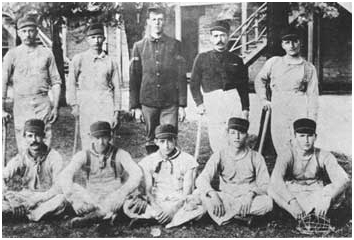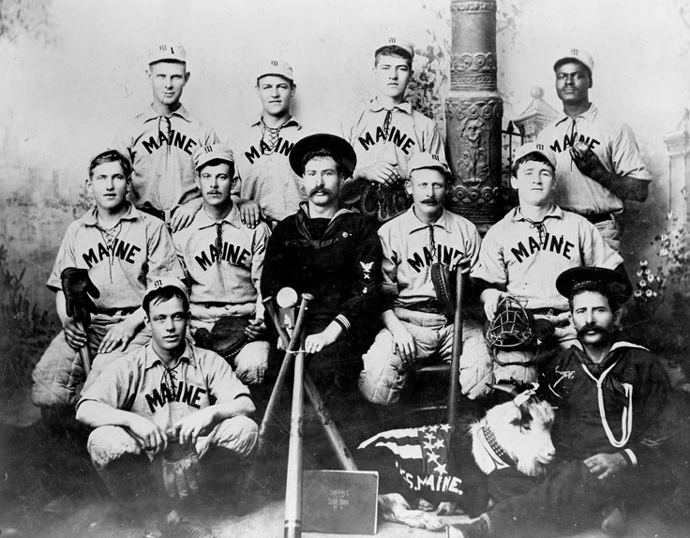Baseball's Greatest Sacrifice Through the Years
Pre-Word War I
The Origins of Baseball and the Start of the Civil War
Whilst baseball’s true origins maybe shrouded in uncertainty, we can
at least confirm that in 1846, New York businessman Alexander J.
Cartwright, reworked the rules of existing ballgames to produce a sport
that closely resembles baseball as we know it today. The first game to
be played by these rules was held at Elysian Fields in Hoboken, New
Jersey that same year.
Just 15 years later, in 1861, baseball players filled the ranks of the
military for the first time as America found itself gripped by civil
war. Since that first game in Hoboken, baseball had spread throughout
New England and the Midwest. Cartwright himself had taken the game to
California and Hawaii, and the sport was growing in popularity in
Virginia, the Carolinas and the ports of New Orleans and Galveston,
Texas.
The civil war meant that baseball’s fledgling organisations suffered
(the number of nationally recognised clubs fell from 62 to 28) while
military baseball boomed. Troops of both the North and South armies
played organised games and pick-up games around their camps and there is
evidence that baseball was also played in prisoner-of-war camps.
The war lasted until May 1865, and in four long years, over 600,000
American lives were lost. It’s safe to say that this was the first time
baseball players made the ultimate sacrifice for their country.
Unfortunately, no records have been uncovered to name these inaugural
heroes.
American Indian Wars
During and after the Civil War, there were a number of conflicts with
Native Americans in the western United States. As baseball gained in
popularity during this time, it is fair to say that a number of
ballplayers would have lost their lives during this time. An 1880s
photograph of the Jefferson Barracks, Missouri, baseball team includes
mention of two of the players (who were serving with the famous 7th
Cavalry) were among the 25 troops killed at the Wounded Knee Massacre of
December 29, 1890, the last battle of the American Indian Wars.
Unfortunately, their names have not become known.

Jefferson Barracks baseball team
Spanish-American War
In Florida, in December 1897, the baseball team of the battleship USS
Maine defeated a team from the cruiser USS Marblehead, 18-3, to earn the
title Navy baseball champions. Led by engine stoker and pitcher William
Lambert of Hampton, Virginia, the only black player on the team who was
described as “a master of speed, curves, and control,” the team’s next
game was scheduled with an all-star squad in Havana, Cuba.
On February 15, 1898, Marine Corps Fifer C.H. Newton, the ship’s bugler
and the ball team’s third baseman, blew taps as the Maine bobbed
listlessly in Havana Harbor. Shortly afterwards, the Maine blew up,
killing 261 of the crew and all but the baseball team’s right fielder,
John Bloomer. In addition to Newton, the bugler, the ballplayers killed
that evening were Ordinary Seaman William H. Gorman (second base) of
Boston, Landsman Charles Hauck (centerfield) of Brooklyn, Landsman
William L. Hough (first base) of New York, pitcher William Lambert,
Apprentice First Class Benjamin L. Marsden (catcher) of Jersey City, New
Jersey, Landsman John Merz (shortstop) of Brooklyn, and Landsman William
H. Tinsman (leftfield) of East Deering, Maine. Also killed were the
team’s manager Gunner’s Mate First Class Charles F. W. Eiermann of New
York, and Seaman Leo Bonner of New York, the manager’s assistant. In
addition, to lose his life aboard the Maine that night although not a
member of the ship’s team was Yeoman Third Class John H. Shillington of
Chicago, who played shortstop with Notre Dame.
Two months after the loss of the USS Maine, on April 25, 1898, saw the
start of the Spanish-American War, during which the rallying cry,
“Remember the Maine! To Hell with Spain!” was frequently heard. Minor
league catcher Leonard Weikart died from illness in Cuba on August 1,
1898. He was possibly the first former professional player to lose his
life in military service. On December 30, 1898, Bill Stearns, a Civil
War veteran who pitched for the National Association’s Washington
Nationals between 1872 and 1875, died from illness that had occurred
while serving with Company H, First District of Columbia Volunteers in
Puerto Rico in August/September of that year.

USS Maine baseball team
World War I
On July 28, 1914, future Hall of Famer Sam Crawford drove in three of
Detroit’s runs as the Tigers snapped the Philadelphia Athletics 12-game
winning streak, with a 4-3 win. That same day marked the start of the
First World War with the Austro-Hungarian invasion of Serbia. The German
invasion of Belgium, Luxembourg and France soon followed, with Canada
entering the war as part of the British Empire on August 5. For the next
three and a half years, war raged across Europe as the United States
pursued a policy of non-intervention, avoiding conflict while trying to
broker peace. Baseball continued pretty well unscathed during these
years. The Boston Braves clinched the World Series in 1914, the Red Sox
took the title the following year, and again in 1916 with a young
pitcher named Babe Ruth making his World Series debut and hurling 14
innings in Game 2 to beat Brooklyn, 2-1.
Things changed, however, after the sinking of seven American merchant
ships by German submarines at the start of 1917. President Woodrow
Wilson called for war against Germany, which Congress declared on April
6, five days before opening day of the major league baseball season. It
was pretty much an unscathed season for the big leagues although
attendance figures dropped from 6.5 million in 1916 to under 5 million
in 1917, and the Selective Service Act, which began in the summer and
drafted 2.8 million men before the war’s end, had a small impact on team
line ups that year.
But as the United States became more deeply involved in the war, an air
of uncertainty floated over ballparks around the country in 1918. Major
league officials chose to follow a business-as-usual approach at the
start of the season and were shocked in mid-July when Secretary of War
Newton Baker and General Enoch Crowder, director of the military draft,
issued a “Work or Fight” order forcing all able-bodied men of draft age
out of non-essential employment and into military service or war-related
jobs. Baseball, they said, was a non-essential occupation. As a result,
players were given until September 1 to comply and both leagues voted to
end their seasons on Labor Day (September 2). The World Series, which
began on September 5, was won by the Boston Red Sox for the fourth time
that decade.
Two hundred and fifty major leaguers entered military service during
World War I, while many others found war-related work. The minor leagues
were virtually shut down and all baseball-related deaths for the war
occurred during 1918. The first was on April 6, when Newt Halliday, a
first baseman with the Pittsburgh Pirates, who had made his big league
debut in 1916 and struck out in his only plate appearance, died from
tuberculosis while serving with the Navy at Great Lakes, Illinois. On
May 24, major league baseball lost another youngster when Ralph Sharman,
an outfielder with Connie Mack’s Philadelphia Athletics, drowned during
a training exercise at Camp Sheridan, Alabama. Four days later, baseball
suffered its first fatality on the battlefields of Europe. Second
Lieutenant Milt Drumm played minor league baseball from 1910 to 1914,
batting a league-high .341 with the Nebraska City Forresters of the MINK
League in 1912. Drumm was killed in action at Cantigny, France on May
28.
Sammy Reid was baseball’s next casualty. A former captain of the
Princeton baseball team, he was killed in action at Chery-Chartreuve,
France on August 22. On August 31, minor league infielder Nick Giacomo
was killed in action in France, while another minor leaguer, John Rice,
died from illness the following month. A further four bush leaguers died
during September. John Cooper, a catcher who had played in the White Sox
organization, died in an accident while serving in France on September
2. Marcus Milligan, a pitcher in the Pirates farm system, was fatally
injured in a plane crash on September 4, while serving with the US Army
Air Service. On September 29, Leroy Bruff, a Blue Ridge League catcher,
became the third minor leaguer to be killed in action, losing his life
during the Meuse-Argonne offensive. And that offensive also claimed the
life of another Blue Ridge League player the following day, Ed Moore, a
catcher with Chambersburg.
October 1918 saw the most baseball-related deaths. On October 2,
Lieutenant James O’Neil, a ball player at Columbia University, died of
wounds received in combat in France. Three days later, major league
baseball suffered its most prominent wartime casualty. Eddie Grant, the
Giants third baseman, was among the first to enlist when the United
States entered the war in 1917. During the Meuse-Argonne offensive, all
of Grant's superior officers were killed or wounded, and he took command
of his troops on a four-day search for the Lost Battalion (nine
companies of the 77th Division, roughly 554 men, isolated by German
forces). During the search, Captain Grant was killed by an exploding
shell. He is buried at the Meuse-Argonne American Cemetery in Romagne,
France.
On October 6, 1918, Jack Inglis, a minor league catcher and one of the
greatest basketball players of the first half of the 20th century, died
from Spanish flu while on leave from the Navy. The Spanish flu was first
detected at an army barracks in Kansas in March 1918. It spread quickly
killing 675,000 Americans and between 20 and 40 million worldwide within
months. Baseball-related victims included major leaguers Harry Glenn and
Larry Chappell; minor leaguers Guy Milliman, Harry Acton, Dutch Hiner
and Ralph Worrell; and Negro Leaguers Norman Triplett and Specks
Webster. On the battlefields of France, the lives of major leaguers Bun
Troy, minor leaguers Orville Kilroy and Leo Dolan, and Matt Lanighan, a
prominent semi-pro player from Lockport, New York, were all lost during
October. On October 12, outfielder Tom Burr, who made one appearance for
the Yankees in 1914, was killed in a plane crash in France, while Harry
Chapman, who played in the big leagues for five years as a catcher, died
on October 21, from battlefield wounds received in France while
hospitalized at Camp Clark, Nevada.
On November 11, 1918, an armistice with Germany was signed but it was
also too late for Pacific Coast
League third baseman Len Hollywood, who was killed in action on November
3. The war to
end all wars had finally ended with over 116,000 Americans killed and
nearly 65,000 Canadian servicemen, including eight major league players,
at least 17 minor leaguers and two Negro League players.
Between the Wars
Coming soon......
Baseball's Greatest Sacrifice is associated with Baseball Almanac
Baseball's Greatest Sacrifice is proud to be sponsored by
